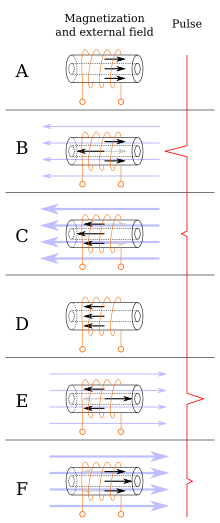Wiegand sensor
Wiegand sensors or pulse wire sensors contain Wiegand wires as an essential component , which have a hysteresis curve with (usually two) pronounced jumps due to parallel soft and hard magnetic areas , a kind of macroscopic Barkhausen effect , commonly known as the Wiegand effect . The sudden change in magnetization causes a voltage pulse in a nearby coil, the size and shape of which does not depend on how quickly the external magnetic field changes. The name goes back to John Richard Wiegand , who dealt with metallic alloys in 1972 and subsequently patented the wires mentioned.
Wiegand sensors are mainly used to detect movement by means of (rotary) pulse encoders and to encode identification means in access control systems.
Layout and function
The most important part of a Wiegand sensor is the Wiegand wire . It consists of a special alloy with a hard magnetic metal as a jacket and a soft magnetic metal as a core. The typical diameter of such wires is 0.25 mm.
A different magnetizability (cladding and core area) can now be observed in these two areas. If you consider the possibilities of magnetization, there are a total of three cases: one in which the core and outer skin are magnetized in the same way, and two with opposing magnetization.
The two areas react differently in the presence of a magnetic field. The hard magnetic jacket only changes its magnetic polarization in the presence of stronger magnetic fields than the soft magnetic core. The entire wire is now surrounded by an external magnetic field in the longitudinal direction, with the sheath and core being equally polarized. The field lines of the soft magnetic metal are based on those of the external field, which is also superimposed by the magnetic field of the hard magnetic jacket.
If the external magnetic field, together with the magnetic field of the cladding, exceeds the coercive field strength of the core, the entire core is suddenly reversed. The reversal of magnetization is associated with a change in the magnetic flux and can be detected as a voltage pulse with the aid of a coil that surrounds the Wiegand wire. Now the Wiegand wire has to be magnetized to such an extent that the core and jacket are polarized in the same direction again. A strong magnetic field is necessary for this.
If both poles of a magnet are moved past the Wiegand sensor, four signals are generated because first the core and then the outer skin of the wire is magnetized. It is also possible to reset the Wiegand sensor using an externally generated field.
Due to the shape of anisotropy , the material has only one Weiss area and therefore almost rectangular hysteresis curves exist .
Manufacture of Wiegand wire
A thin wire (diameter approx. 300 µm) is produced by cold forming and subsequent tempering . The core of the wire is soft magnetic due to the special manufacturing process , while the outer skin is hard magnetic. The manufacture also requires that the magnetic moments are oriented in the axial direction.
application
The Wiegand sensor is used, among other things, in access cards, rotary encoders, as well as position and proximity sensors .
Access cards
A number of short Wiegand wires are embedded in an access card (door card). A reader detects the impulses of the Wiegand wires when they are pulled through and compares them with the previously stored reference pattern. Additional security features such as a magnetic strip can also be applied and queried. Due to the complicated production of the Wiegand wire, the Wiegand cards are considered relatively forgery-proof.
Speed measurement (with pole wheel)
A series of Wiegand wires are embedded along the outer circumference of a pole wheel. An externally attached reading head records the pulses from the Wiegand wires.
Rotary encoder
Wiegand sensors are used here to record the revolutions of magnetic multiturn absolute encoders in the de-energized state. If the shaft of the rotary encoder is rotated, a magnet attached to it generates a variable magnetic field on the stationary Wiegand sensor. The voltage pulses generated thereby are used to store the revolutions in a non-volatile memory. This mechanism also works at very slow speeds , it replaces the gearbox / battery that is otherwise used to store the revolutions.
Individual evidence
- ↑ The Wiegand effect and its application. In: okn-software.de. Retrieved June 24, 2016 .
- ↑ David J. Dlugos: Wiegand effect sensors: theory and applications. In: Sensors magazine. Questex Media Group, May 1998, accessed June 3, 2012 .
- ↑ Patent US3820090 : Bistable Magnetic Device.
- ↑ Physical Access Control Systems. (PDF; 2.1 MB) BlackHat.com, accessed on February 13, 2013 (English).
- ↑ White paper Magnetic Encoder. (PDF; 365 kB) FRABA, p. 3 , accessed on February 13, 2013 (English).
- ↑ Electromagnetic encoders without backup battery. (PDF) In: Polyscope: The specialist magazine for industrial electronics and automation. Binkert Medien, September 2012, accessed on July 13, 2015 .
